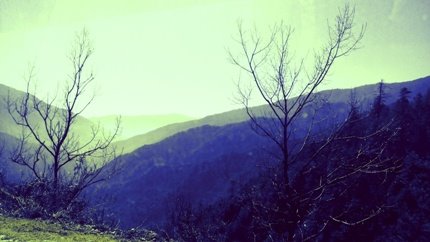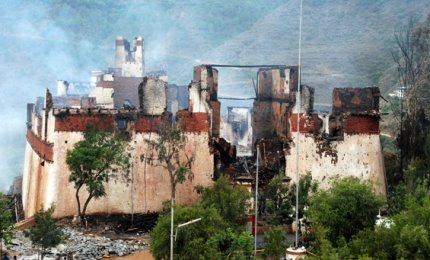Tourist Attractions of Wangdue Phodrang
A well-deserved tourism hub in Central Bhutan, Wangdue Phodrang offers discerning tourists an array of natural and cultural delights. As with most other districts the Wangdue Phodrang district is also dominated by a dzong (monastery + official quarters).
Legends say that Zhabdrung Rinpoche once encountered a beautiful little boy playing by the riverside and was so touched by his innocence that he decided to name the dzong Wangdi’s palace and therefore the whole district is called Wangdue phodrang or Wangdue or Wangdi.
This huge 4308 sq. kilometre district has a lot of variance in altitude and has cool snow bound northern regions as well as lush sub-tropical forests in south
The road from Punakha to Wangdue…
note the blackish colors of the mountain range
How to Reach
Most tourists choose to stay either in Punakha or Wangdue before proceeding onwards to Trongsa-Gangtey-Phobjika Valley etc.
From Thimphu to Wangdue the full cab fare is 1190 NU (the distance is 106 km). If you approach Wangdue via the Southern border town of Gelephu then you should know that from Gelephu to Wangdue the distance is 214 km and the full cab fare is 3332 NU. From the Western Bhutan border town Phuntsheoling to Wangdue, the distance is 261 km and the full cab fare is 3893 km.
Another big tourist destination near Wangdue is Phobijka and it is 29 km and the cab fare is 1088 NU. From Punakha to Wangdue the distance is only 39 km and the cab fare is 1500 NU. You can also travel from Daga to Wangdue (the distance is 196 km) and the fare is 2856 NU. From Paro to Wangdue the distance is 147 km and the taxi fare is 1488 NU.
What to see in Wangdue Phodrang
Wangdue Town/ Bajo
The Wangdue town looks like its wrapped and frozen in the 16th century and you will constantly have a feeling of having travelled back in time. There are very few shops and people still survive by occupations like farming and animal husbandry.
The most notable attraction of the town is its bamboo weaving and slate carving culture. For several generations, families of craftsmen have been selling their woven bamboo products and slate/ stone carvings in the local market and its where you can pick up interesting souvenirs and home décor items. Try visiting the Wangdue town (it’s called Bajo now) on Sundays or Saturdays.
Wangdue Phodrang Dzong
This 1638 built Dzong sits on top of a high rising cliff overlooking Wangdue town. The dzong tragically caught fire in 2012 and the gigantic work plan of rebuilding it will go on till the year 2021.
The ruins of the Dzong one day after it was burnt down
Source: The Bhutan Observer
So, if you visit the wangdue phodrang district now, you won’t be able to visit the dzong. However, I did gather some beautiful stories about the dzong from the locals. When Buddhist monks were looking for an appropriate site for the dzong, there were four ravens who flew in 4 separate directions and this was deemed to be a sacred symbol denoting the spread of Buddhism in all four directions.
The governor of this dzong (called penlop) had control over the routes to Dgana, Trongsa, Punakha and Thimphu. The dzong stands at the confluence of two rivers; Pho Chu (male) and Mo Chu (female).
Rinchegang Village
If architecture and history fascinates you then stop over at the Rinchegang Village which lies just a few km away from the Wangdue Dzong. The small village is home to Bhutan’s finest stone carvers and you can see the traditional Bhutanese method of Stone Masonry.
If you want, you can hike uphill the same hillock leading to the village. For photographers, this is an ideal spot as the view encompasses river, dzong and the valley. You can see the Rinchegang village on your way to wangdue phodrang town from Punakha as it’s the last village of Western Bhutan.
Sha Radap Temple
The temple of Sha Radap is also called Rada Lhakhang and its located quite near the Wangdue Phodrang Dzong. The Sha Radap celebrates the guardian goddess of the wangdue region and she is named as Sha Radap. It’s a local custom to bring new born children here to get them named and blessed by presiding monks. An interesting custom is to roll the dice kept in the Temple compound and utter your wishes silently while the deity there blesses you with the fulfilment of your wish. The shaa region lies to the east of Wangdue and is populated by a cult of nature worshipping Buddhists.
Gasleo and Nahee Village
The twin villages of Gasleo and Nahee lie to the western side of Wangdue (takes 2 hours to reach them). They are ideal spots for having a picnic and you can even plan for a day trip for exploring these villages. You can experience rural Bhutanese life in its purest form at these villages and farmers and house holders there have a very friendly attitude towards tourists. Autumn is the best time for a village excursion to these places as that’s the harvest time.
Adha and Rukha Villages
To the South of Wangdue town lies the rural gems of Adha and Rukha Villages. There are opportunities here for tenting and enjoying an adventurous night under the starlit sky. You can also opt for boosting the village economy by choosing to stay at one of the many farmhouses that are available in the village.
These villages are at low altitude and have tropical vegetation which means that summers here are not so pleasant with the incidence of sand flies, buzzing mosquitoes and leeches. However, if you are travelling in autumn, winter or spring then you will have a wonderful time.
The villagers are extremely friendly and will demonstrate their Bhutanese recipes for making fish roast while the older folks will regale you with tales of monarchs, demons, princesses and mermaids. You can also participate in the Adha Rukha Black Mountain National Park trek (see below).
Black Mountain National Park/ Jigme Singye Wangch National Park
The rocky mountain dotted black mountain park is one of the largest protected natural reserves in Bhutan. Exotic varieties of fauna are found inside this park and they include musk deer (their glandular secretions are more expensive than gold), goat antelopes, red pandas, fierce wild boars, golden skinned langurs and tigers.
However, the crowning glory of the park are Clouded leopards one of the most dangerous and beautiful arboreal members of the cat family. Their hunting prowess and climbing skills are legendary. Broadleaf forests, fir forests, blue pine forests, juniper forests, alpine meadows hold more than 270 species of birds and 139 species of butterflies.
There is a guesthouse in the part but you must seek prior written permission from the government to stay inside it. A good way to explore the western part of the park is to participate in the Adha Rukha Community tourism programs. They have a 6 day 5-night trek that explore the flora and fauna (selected regions) along with sensitisation to endangered species like white heron and endangered languages like Oleps. You can experience the nuances of rural life as well as forest life in this trek. The treks are managed by JSWNP committee and have been operational since the last 2 years.
Related Articles
|
Visitors' Reviews/Comments
|

